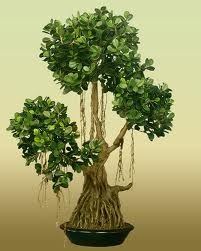 Since bonsai trees are meant to be grown in a container, you’ll want to select an appropriate one to foster the growth of your tree.
Since bonsai trees are meant to be grown in a container, you’ll want to select an appropriate one to foster the growth of your tree.
The bonsai with its container and soil are physically independent of the earth since its roots are not planted in it. It is a separate entity, complete in itself, yet part of nature. This is what is meant by the expression "heaven and earth in one container".
A bonsai tree should always be positioned off-center in its container, for not only is asymmetry vital to the visual effect, but the center point is symbolically where heaven and earth meet, and nothing should occupy this place.
Another aesthetic principle is the triangular pattern necessary for visual balance and for expression of the relationship shared by a universal principle (life-giving energy or deity), the artist and the tree together. Tradition holds that three basic virtues are necessary to create a bonsai: truth, goodness and beauty. These three form the triangle that represents bonsai.
Since roots must be pruned on plants for bonsai, the initial containers are different from the traditional containers used later in the plant’s development. The beginning containers are called training pots.
Just about anything will do that will hold the heavy roots, but it is a good idea to choose something similar to the sort of pot the plant will be placed in once the roots are small and fibrous.
Cascading plants should be trained in deep pots, while tall specimens that will end up in shallow pots need to begin in fairly shallow containers. Make sure that the drain holes in all training pots are at least one half inch in diameter.
Traditional bonsai pots, available from large nurseries and some import stores, are round, oval, square, rectangular, and hexagonal. Cascade and semi-cascade styles of bonsai look good in round or rectangular pots.
You should place the plant in the center of the pot with the branches sweeping over the sides. Upright trees should be placed off center (about one third the distance from the edge) in rectangular or oval pots.
The pot needs to complement the tree and not be very big – usually the depth of the pot should equal the thickness of the trunk of the plant – but this law doesn’t always have to be obeyed.
Select a wide and shallow pot to keep the attention on the planting itself. The wide, flat planting gives the feeling of calm serenity found in the deep forest. Find a container whose length is about two-thirds the height of the tree.
If the tree is wider than it is tall, use the width as your gauge for the pot size. Find a planter with a width two-thirds the height of the tree and a depth of approximately 1 1/2 times the trunk diameter.
Use colors that complement the tree – a brightly colored pot for a flowering tree or for a deciduous tree that has stunning fall leaves or more muted and solemn colors for a pine or cedar. Look at the bark of your tree. If it has a rough texture, a bit of texture on the pot itself works well.
Remember that no pot is permanent. Your tree will require repotting over the course of time to keep it from becoming root bound. We’ll address re-potting in another chapter.
After the bonsai has been potted you can now add moss or other small plants around it to give the impression of a fully sized tree in nature.
You’ve got your tree, you’ve got its container, now let’s look at how to prune and shape your bonsai.

Deprecated: strpos(): Passing null to parameter #1 ($haystack) of type string is deprecated in /home/agriviek8Qv/agriviet.net/public_html/wp-includes/comment-template.php on line 2522